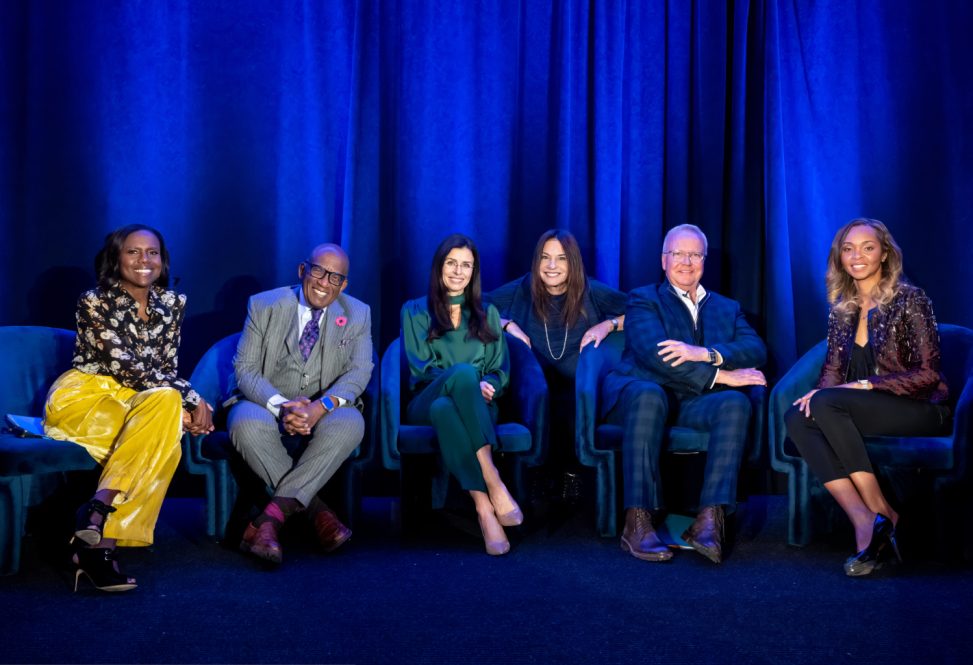On Monday, Rebecca Puhl of the UConn Rudd Center for Food Policy and Health was featured as a panelist for “Weight Stigma and Media: Addressing the Impact” – a national media event in New York City hosted by the Media Empathy Foundation. On the panel, Puhl was joined by Al Roker from “Today” at NBC, Deborah Roberts of ABC News and 20/20, David Sloan (Senior Executive Producer of ABC News Studios), and Dr. Holly Lofton from NYU School of Medicine to discuss how weight stigma persists in entertainment, news, and social media.
In addition to her role as the Deputy Director for the UConn Rudd Center for Food Policy and Health, Puhl is a Professor in the Department of Human Development and Family Sciences. We sat down with her to discuss the media event.
At this event, you discussed the findings of a survey study that the Media Empathy Foundation conducted earlier this year. What were the main findings of and key takeaways from their survey?
This new study by the Media Empathy Foundation surveyed 1,200 U.S. adults about their views of how body size is depicted in the media. Findings highlight a clear pattern of stigmatizing media portrayals, reiterating the lack of representation of people of diverse body sizes in the media and negative and stereotypical depictions of people with higher weight in television, movies, and social media. The majority of survey respondents said that TV shows and movies often engage in body shaming, that health reports tend to blame people for their weight, and that people of higher body weight are often excluded from leading roles in TV shows and movies; 80% felt this sends a negative message.
We know from our prior research that when people view television shows and movies that stigmatize people about their body size, it worsens public attitudes and increases weight bias. The mass media has a powerful influence on public attitudes and is contributing to harmful messages that promote societal weight stigma.
From your perspective, what needs to change to reduce weight stigma in entertainment media?
Across all levels of the media, there needs to be better representation and more respectful depictions of people with diverse body sizes. There needs to be more realistic and meaningful stories that are inclusive and fair, and that portray people of higher body weight as multi-dimensional human beings living multi-faceted lives. Their stories need to go beyond characters being defined or limited by their body weight or size. Today, overweight and obesity affect 2/3 of American adults, and yet they are not seeing themselves or their stories represented or respectfully reflected in the media.
Changing this requires casting more people with diverse body sizes – not just as secondary characters or as an afterthought, but as leading characters who have meaningful stories to tell. It also means not typecasting people with higher weight in the ‘comedic sidekick’ role; about 60% of survey respondents said that TV shows and movies portray people of higher body weight as the target of jokes, and as lazy or unmotivated. So, media content creators need to look more carefully at how these characters are being written into storylines, and remove depictions that reinforce stigma to replace those with more respectful portrayals.

The panel also discussed the problematic ways that the news media covers obesity. Can you explain this?
Within the news media, the narrative about obesity and weight loss is often inaccurate and oversimplified. The common messages of “eat less, exercise more” or “calories in, calories out” doesn’t reflect the science showing that body weight is complex and driven by the interaction of multiple factors beyond food intake and physical activity – many of which are outside of person’s control, such as environmental, biological and genetic factors and social determinants of health. This complexity needs to be acknowledged in the news media, and needs to replace the oversimplified narratives that often permeate the media and reinforce societal blame of people for their weight. There is not a pithy soundbite that can accurately explain the complexity of body weight.
Moreover, the news media often make generalizations that all people with a higher body weight are unhealthy, which is inaccurate. People can be healthy at different body sizes, and they can be unhealthy at different body sizes. The American Medical Association recently announced a new policy to recognize the limitations of BMI as a measure of health, and the news media needs to do the same and acknowledge that a person’s weight status or BMI is not sufficient to infer a person’s health status; rather, body weight is one piece of information that needs to be considered in conjunction with many other indices of health.
This event brought together representatives from many of the top media companies around the world – a promising sign that key players in this space are paying attention to this issue. However, what are some roadblocks that still stand in the way of large-scale change moving forward?
One roadblock is that media standards that have been applied to reduce other forms of societal prejudice are not being applied to body size. There is a lack of awareness and education about weight stigma, and if it’s not on the radar, media professionals can’t avoid stigma in their content. If content creators can become more aware of weight stigma and its harmful impact, they can write and report differently.
Another roadblock is the lack of engagement with people who have lived experience of weight stigma. At all levels of the media industry, we need to see more inclusion, which means engaging with, learning from, and including the perspectives of people with larger bodies. If this was happening, I think we would see more compassionate and respectful portrayals of people of diverse body sizes in the media.
What are some tips you can give to people working in media to make their content more inclusive and respectful when portraying people of all body sizes?
When journalists are reporting on obesity, they need to acknowledge the multiple and complex factors involved; this requires seeking multiple perspectives and engaging in comprehensive reporting to ensure that the content is grounded in scientific evidence. When reporting on people who have obesity, it’s important to acknowledge the diversity of this population and avoid language or inferences that reinforce weight-based stereotypes.
Content creators working in entertainment media need to examine how the dialogue and actions of the characters they write into storylines may contribute to weight bias. They should be asking the question ‘is this a respectful and fair depiction or is it reinforcing negative stereotypes?’ and ‘what impact will this character have on viewers?’ They need to look for ways to challenge weight-based stereotypes in their characters and increase representation of body size diversity of characters.
Weight stigma in the media has existed in blatant and subtle ways for decades, and while we are starting to see an increase in more positive portrayals of people with higher body weight, most depictions continue to reinforce the message that only some body sizes are acceptable. This media event is an important call to action for the media industry to treat people of all body sizes with compassion, respect, and dignity.



